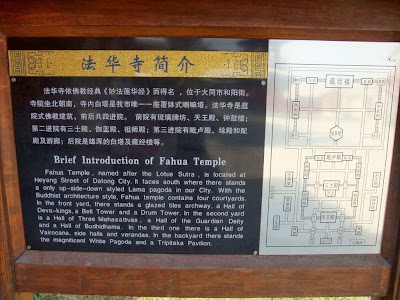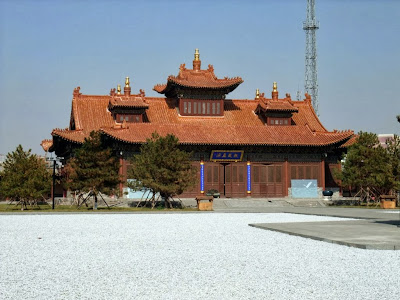
Temple Fahua-si is located at the northern side of Heyang Street in Datong City. The existing temple site began to rebuild in year 2008 and just opened for public on 1st October 2010. The old one that found in Ming Dynasty was totally abandoned with only a white pagoda remained at the site. The site now covers an area of 75 acres and is designed in a courtyard style, like most of the traditional Buddhist complex in China. There are three sections with archway gate, Lokapala Hall and Bell and Drums tower standing in front. The archway is built with color glazed tiles. Main Shrine Hall and Three Mahasattvas Hall are in the central court on its central axis lining from north to south. The old Lama Pagoda and newly built Tripitaka Pavilion are situated at the back yard.


Behind the particularly remarkable gazed tiles archway are the modern drum and Bell towers which are round in shape with pointed roof. The Lokapala Hall that enshrines the four Heavenly Kings looks neat and elegant.



We tip-toed into Lokapla Hall as an old Dharma worker was falling into sleep at this noon moment.



The Main Shrine Hall is constructed in the style of Yuan Dynasty.


Purify ourselves and be happy always, it states at the tablet.



The Three Mahasattvas Hall enshrine Images of the three sages, Bodhisattva Manjushri, Samantabhadra and Avalokitesvara.


The murals here are rich in colors and figures are with strong flavor of the foreign cultures.


There are many different characters found in the murals reflecting the combination of culture in various ethnics as well as from other nations.


Murals at this side focus on Buddhist Characters.


The Tibetan styled White Lama Pagoda built in the shape of an upside vase is the only one of the kind existing in Datong City. It was the building dated from Yuan Dynasty (916-1125), the only structure remained at the site from that period. The beautiful Tibetan building behind it, is the newly constructed Tripitaka Pavilion.



The 18 meter high ancient pagoda was built on a two meter high platform with two layers of foundation in octagon shape. The total perimeter is about 14 meter in length. There are 4 windows opened at four directions each enshrined with an image of Vajra carved out from bricks. Precious stones are inlaid at its spiral top which is further adorned with yellow, green and purple gazed tiles.




By west corner of the Pagoda, there is a kiln kind of hole carved with three Chinese character Xiao-dong-tian (小洞天), meaning A Little Fairy Grotto. It was said that originally there was a Buddha Statue. The top part of the platform could be directly reached from two sides of the hole.



Fahua-si also has Guardian Hall, Bodhidharma Hall and Arahat Hall inside its temple site beside its few main structures.


Along Heyang Street, we visited the nine dragon screens which is the oldest and largest of such kind in China. It was built 600 years ago for Prince Hongwu, the 13th son of Zhu-Yuanzhang, the first Emperor of Ming Dynasty (1368-1644)


Though the palace was no more existing, the 45.5 meter long x 8 meter high x 2.02 meter wide screen was very well preserved and remains intact at time of our visit.


The screen that was made up of 426 specially burnt glazed tiles is divided into three parts. The 2.09 meter tall pedestal is rectangular in shape with a narrow part at center, composed by 75 glazed tiles with animals designs. The top roof was also covered with glazed tiles. The nine flying dragons were on the main central portion of the screen, with green colored waves design at lower end and blue, yellow color cloud on its upper area. Spaces around them are supplemented with design of nature sights, plants and vegetation. It is indeed a great piece of work.



The life-like dragons illustrating the power of summon the wind and control the rain were produced in three dimension. The purple dragons at 3rd place are as if wrestling with sea monster, they look fierce and forceful.



The most vigorous pair are at the corners while the yellow colored pair next to the purple dragons are most elegant in appearance.



The central dragon is with golden scales and shinny eyes and immediately next to it are a pair of pale yellow dragons with heads facing outwards.



The nine dragons, as if flying amidst the clouds, water, mountains and in fogs, look gorgeous. It receives less attention as there are too many similar or identical looking of its kind throughout the whole China.


Pond with stone bridge in front of the screen had dried up. We missed the chance to witness the dragons dynamic reflection on the water.


The site is currently taken care by an imperial offspring from Zhu family of Ming Emperors. It's a pity there is no much maintenance at the surrounding.


No comments:
Post a Comment